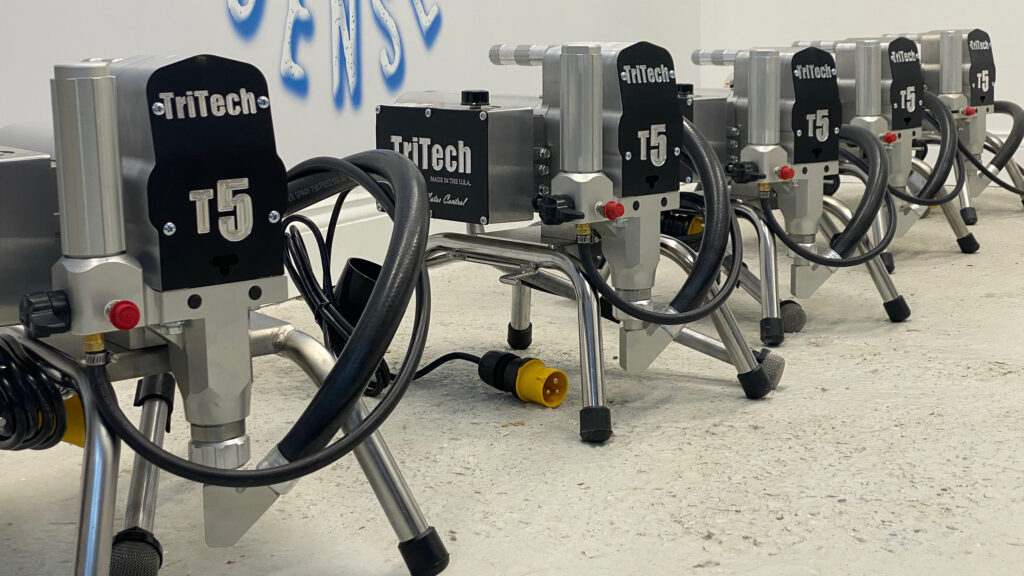The following article provides an introduction to Airless Spray Equipment and discusses the basics, how it is used, and what benefits it can provide to the user.
What is airless spraying?
Airless spraying is a system that sprays paint without the use of compressed air. Traditionally sprayers have used a compressor to generate air to atomise the paint. An airless system, as you would imagine, does not use air.
The way it works is that the airless system pumps the paint along with a hose to a spray gun at very high pressures, typically 2000 psi. The paint is then pushed through a tiny hole (17 thousandths of an inch), which smashes the paint stream into a mist.
The advantage of airless spraying is that for large areas, it is very fast. Some sprayers can deliver 5 litres per minute to the surface, which translates to 60m2 per minute. In the real world, if you are spraying rooms, it is more like 6m2 per minute. A typical 50m2 will take around 8 minutes to paint.
Obviously, if you were spraying a huge warehouse and using a big tip, you could paint a lot more area a lot faster.
The technology has come on in leaps and bounds, and these days you can buy a small airless sprayer and use it with fine finish tips to successfully spray woodwork to a fine finish. Spraying woodwork with an airless sprayer is very productive and is up to 10 times faster than applying paint by brush. If you are priming all the woodwork in a 4 bedroom house, this means you could complete the work within the hour instead of a day and a half.
What equipment is used with airless spraying?
When you buy an airless sprayer, you will get everything you need in the box when it arrives. An airless system is made up of several parts, and these are as follows.
The pump
This has a suction tube that you put into the paint and pump the paint down the hose to the gun. The size of the pump will determine how fast the sprayer will work. A small pump may only pump 1.9 litres per minute, whereas a larger (more expensive) pump will spray 5 to 10 litres per minute.
Most airless sprayers use a piston pump which uses a piston as a pump. The size of this piston is one of the things that determines how fast the sprayer will pump the paint.
The hose
On a standard airless system, the hose is 15 metres long. This enables the decorator to keep the pump in one place and reach all corners of the house. Hoses can be bought in various lengths, and shorter hoses are recommended for working in a small space.
The hose is pressure tested to 12,000 psi and is stiff and inflexible, especially when under pressure. To make spraying more effortless, you will need to add a whip hose (a short flexible hose) between the hose and the gun.
The gun
The gun is just a way of turning the flow of paint in and off using the trigger. The gun has a filter in the handle that makes sure that no large particles block the tip. The tip is inserted into the gun, which converts the paint stream into a spray. The tip determines the fan width and also the quantity of paint that is sprayed. This makes setting up the gun really easy as the tip does all the work; there are no knobs or dials.
Download Now – Find Out How To Access Funding For Training – Get £5,000 Free Funding [FREE DOWNLOAD]
How to use airless spray equipment
You could write a whole book on using airless spray equipment; however, we will keep it simple here. The most challenging part is when you first set up the sprayer to spray, and here, we will outline a step by step approach. For more information, download our free book “Simple steps into spraying – book 1 airless”.
Stage 1 – Prime the sprayer
Step 1 – Plug the sprayer in (obviously)
Step 2 – Put the suction tube into the paint.
Step 3 – Turn the “prime/spray” switch to “PRIME”, turn on the sprayer, turn the pressure up.
Step 4 – Once primed (it takes about 10 seconds), turn down the pressure to zero and switch off for a second to think.
We are going to stop here for a second. This next bit is not complicated, but it may seem like it is. You will have water in the hose from when you cleaned it out. You need to clear the water from the hose and fill it with paint.
To do this, you will have to turn the sprayer to “SPRAY”, but the pressure will build up when you do this. You do not want that at this stage because you want to run the water into a bucket, and if it’s under pressure, that will be very messy.
Take the tip and tip guard off the gun, and this will make this stage easier.
You need to pull the trigger on the gun BEFORE you turn to “SPRAY” so that the pressure cannot build up.
Then slowly turn the pressure up, and the water will start to run out of the hose. I have outlined this on the next page.
Stage 2 – Flush out the water until you get to paint.
Step 5 – Turn the sprayer back on.
Step 6 – Point the gun into an empty bucket and pull the trigger.
Step 7 – Switch the “Primer/spray” switch to “SPRAY” and turn the pressure up slowly.
Step 8 – The water will run out of the gun as the paint makes its way along with the hose. This will take about 30 seconds.
Step 9 – Once you see paint, turn the pressure down and switch it off.
Stage 3 – The final stage, test the spray pattern.
Step 10 – Switch on the sprayer, switch to “SPRAY”, and turn the pressure up. This time the pressure will build up, the gauge will show this and once up to pressure, the sprayer will go quiet.
Step 11 – Spray a test area of the wall to see what the spray pattern is like. You want it nice and solid.
Step 12 – Turn up the pressure until the spray pattern is like a letterbox.
The last stage is essential. If the paint is not atomising enough, then you can do two things.
Turn the pressure up until the pattern is solid. If you are at full pressure and you still have tails, then you can thin the paint. Another tip is that warm paint is better than cold paint, so getting the paint up to room temperature helps a lot. You can get heated hoses, but that’s more advanced and more expensive.
To summarise.
Prime the sprayer, Flush the water out of the hose, Test the spray pattern until correct. Easy.
Don’t overthink it. If it is your first time setting up, take your sprayer outside and practice with water first to feel how the spray/prime switch works and how the sprayer feels when it is spraying. This will help take away the fear as well. Maybe spend all afternoon doing this.
When you are under pressure to paint a job, this is not the time to start learning. Do it one Sunday afternoon when it does not matter if you struggle a little.
Once you get to this stage, you have got further than many decorators, and from now on, it gets more fun and easier.
We think the fear factor is what holds us all back from getting into spraying, and once you get to this stage, you will wonder what you were bothered about.
Checklist of equipment and explanation
- Airless sprayer: This type of spray equipment uses a high-pressure pump to spray paint. The paint is at 2000 psi when it comes out of the tip, and this is enough to atomise it without air.
- Cleanshot valve: A device made by Graco which fits on the end of your extension pole to prevent spitting. An extra valve at the end of the pole shuts off the flow of paint when you release the trigger at the gun.
- Diaphragm pump: A pump design uses a flexible membrane and pulsating hydraulic fluid to produce pressure, different from the piston pump (some would say better). Check out the Wagner Finish range.
- Electronic pressure control: This regulates the pressure electronically rather than mechanically to provide more precise control.
- Fine finish tip: This is a specially designed tip for better atomisation on surfaces where a better finish is needed, such as doors and skirting. Wagner makes a Fine Finish tip. Tritech makes an Ultrafinish tip.
- Orifice: The hole in the tip that the paint passes through. This is a tiny hole and is measured in thousandths of an inch. This is shown by the second part of the number stamped on the tip. For example, 517 is a 17 thousandths of an inch orifice. The size of the hole controls the amount of paint that is put on the surface. The bigger the hole, the more paint is put on.
- Packings: The material used to make the piston liquid-tight and therefore build pressure. These need changing every couple of years.
- Pole: AKA extension pole, this screws on the end of your gun to give you more reach. Available in several sizes. These can be used to paint ceilings or to make spraying walls easier. These can be screwed together to give extra reach if needed.
- Pressure roller: This is a roller that fits on the end of an extension pole and is fed paint by the airless sprayer. This eliminates the need to keep dipping the roller in paint and, in theory, creates less overspray.
- Return tube: The smaller tube that returns the material back into the paint container when the pump is in prime mode.
- Spray tip: This slots into the tip guard and is the business end of the airless sprayer. This controls the fan width and the amount of paint sprayed onto the surface. These wear and need to be changed when done.
- Throat seal liquid: AKA “TSL” This is a lubricant that is placed in a small cup at the top of the piston to keep the packings wet and lubricated. This needs to be done every four hours of continuous use.
- Whip hose: A thinner flexible piece of hose between the end of the high-pressure hose and the gun. This is more flexible and makes for a more leisurely day spraying.
Why would you use airless spraying equipment?
The main reason that decorators use airless spraying equipment is speed. There are other reasons, for example, the finish is better, but speed is the main one. Why is speed important? Well, speed means money. Here is an example.
We worked on a large job that involved decorating apartments. These were various sizes, but I will use the 2 bedroom apartment as an example for this blog. The previous decorating company had been brushing and rolling the apartments, and on average, a decorator took a week to complete one.
We came along and started to spray the apartments thoroughly, with no brush or roller insight, and on average, we completed 2 a week. This means that the decorators, who were on a price per apartment, doubled their weekly income.
This is a lot!
More money is the number 1 reason that decorators use airless spraying equipment instead of the traditional brush and roller. There are other reasons, of course, and here are some.
- The finish is better, especially on the woodwork where you can get a near factory finish.
- It is physically easier. It is much easier to spray a ceiling than roll a ceiling. It is easier to spray skirting than to get down on your knees and brush them. Every job is easier when you spray; you do not go home exhausted at the end of the day.
- It is fun. A final unexpected reason for spraying is that it is fun. We see many decorators once they start spraying with a big smile on their face. Spraying has put the zest back into the job, and they are loving it again.





